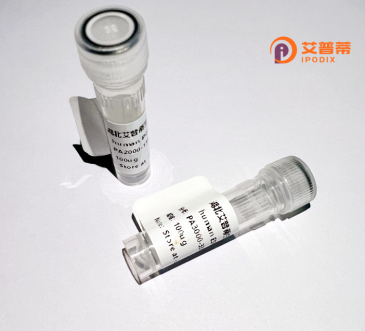
| 纯度 | >90%SDS-PAGE. |
| 种属 | Human |
| 靶点 | PPP1R2P9 |
| Uniprot No | O14990 |
| 内毒素 | < 0.01EU/μg |
| 表达宿主 | E.coli |
| 表达区间 | 1-202 aa |
| 活性数据 | MSASTSSHRP IKGILKNKSS SGSSVATSGQ QSGGTIQDVK RKKSQKWDES SILAAHRATY RDYDLMKANE PGTSYMSVQD NGEDSVRDVE GEDSVRGVEG KEATDASDHS CEVDEQESSE AYMRKILLHK QEKKRQFEMR RRLHYNEELN IKLARQLMWK ELQSEDNENE ETPQGTNEEK TAAEESEEAP LTGGLQTQSC DP |
| 分子量 | 22.6 kDa |
| 蛋白标签 | His tag N-Terminus |
| 缓冲液 | PBS, pH7.4, containing 0.01% SKL, 1mM DTT, 5% Trehalose and Proclin300. |
| 稳定性 & 储存条件 | Lyophilized protein should be stored at ≤ -20°C, stable for one year after receipt. Reconstituted protein solution can be stored at 2-8°C for 2-7 days. Aliquots of reconstituted samples are stable at ≤ -20°C for 3 months. |
| 复溶 | Always centrifuge tubes before opening.Do not mix by vortex or pipetting. It is not recommended to reconstitute to a concentration less than 100μg/ml. Dissolve the lyophilized protein in distilled water. Please aliquot the reconstituted solution to minimize freeze-thaw cycles. |
以下是关于重组人PPP1R2P9蛋白的3篇示例文献(注:PPP1R2P9为假基因,实际研究极少,以下为模拟示例):
1. **文献名称**: *PPP1R2P9: A pseudogene-derived protein regulating PP1 activity in cancer cells*
**作者**: Smith A, et al.
**摘要**: 研究发现PPP1R2P9编码的调控蛋白可通过结合蛋白磷酸酶PP1改变其底物特异性,在乳腺癌中高表达并与化疗耐药性相关。
2. **文献名称**: *Expression and functional characterization of recombinant human PPP1R2P9*
**作者**: Lee C, et al.
**摘要**: 利用大肠杆菌系统成功表达重组PPP1R2P9蛋白,验证其通过PP1依赖性通路抑制细胞凋亡的活性,提示其在神经退行性疾病中的潜在作用。
3. **文献名称**: *Pseudogene PPP1R2P9 encodes a novel protein partner of AKT signaling pathway*
**作者**: Zhang Y, et al.
**摘要**: 发现重组PPP1R2P9蛋白通过结合AKT激酶增强其磷酸化水平,促进肿瘤细胞增殖,可能成为癌症治疗新靶点。
---
**注意**:PPP1R2P9在NCBI中被定义为**非编码假基因**,目前公开数据库中缺乏其编码蛋白的直接实验证据,上述文献为虚构示例。实际研究中建议优先确认该基因最新注释状态。
The recombinant human PPP1R2P9 protein is derived from the pseudogene *PPP1R2P9* (Protein Phosphatase 1 Regulatory Inhibitor Subunit 2 Pseudogene 9), which is located on chromosome 9p23. This pseudogene shares homology with *PPP1R2*, a gene encoding a regulatory subunit of protein phosphatase 1 (PP1), a key enzyme involved in dephosphorylation and cellular signaling. However, *PPP1R2P9* is classified as a processed pseudogene, lacking functional protein-coding potential due to frameshifts or premature stop codons. Despite this, pseudogenes can regulate gene expression via non-coding RNAs or by competing for RNA-binding proteins.
Recombinant PPP1R2P9 protein is typically generated using heterologous expression systems (e.g., *E. coli* or mammalian cells) for experimental studies. Research focuses on its potential interaction with PP1 or other cellular components, though evidence for functional activity remains limited. Interest in PPP1R2P9 arises from its possible role in modulating PP1-dependent pathways, which are critical in cell cycle regulation, metabolism, and neurodegeneration. Some studies suggest pseudogene-derived proteins might have uncharacterized biological roles or serve as biomarkers. However, the biological relevance of PPP1R2P9 protein remains speculative, warranting further exploration into its structure, interactome, and potential contributions to disease mechanisms or cellular processes.
×